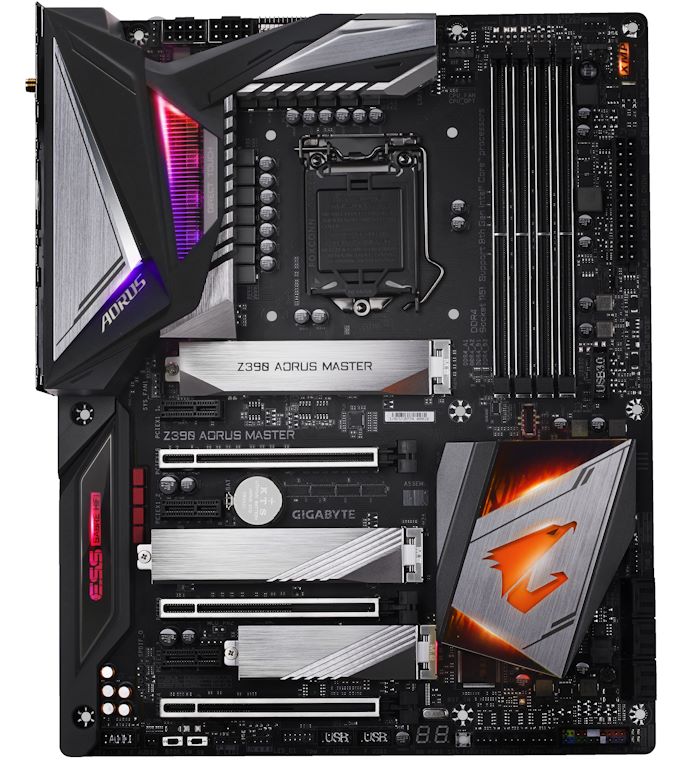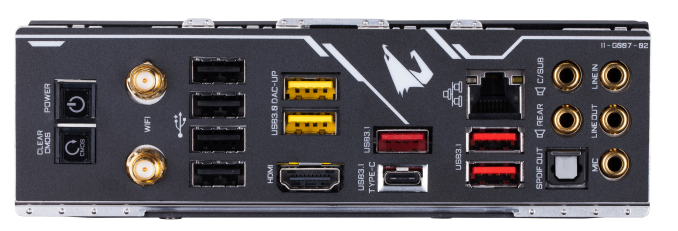Intel Z390 Motherboard Overview: 50+ Motherboards Analyzed
by Ian Cutress & Gavin Bonshor on October 8, 2018 10:53 AM EST- Posted in
- Motherboards
- Intel
- MSI
- Gigabyte
- ASRock
- EVGA
- Asus
- NZXT
- Supermicro
- Z390
GIGABYTE Z390 Aorus Master
Just like we noted in our AMD B450 launch motherboards overview, GIGABYTE has gone through a transitional period of late when it comes to branding. To make their naming scheme a little easier to decipher, the move isn't just for the benefit of users looking to distinguish between different types of motherboard, but it also allows GIGABYTE to tie in different components such as graphics cards and align them together from a marketing perspective. The new naming scheme essentially narrates the class of motherboard so for example, the AORUS Gaming 9 which was GIGABYTE's Z270 flagship is now known as the AORUS Xtreme. Other examples of GIGABYTE moving away from a numbering naming scheme include the AORUS Z390 Master which replaces the AORUS Z370 Gaming 7 and the Z390 Aorus Elite which is the successor of the Aorus Z370 Gaming 3. For the Z390 chipset launch GIGABYTE has announced a total of 11 new motherboards.
GIGABYTE Z390 Aorus Master
Starting off with one of the most unique offerings from GIGABYTE is the Z390 Aorus Master which is the only board from GIGABYTE's line up to feature a backplate. On top of this, the Z390 Aorus Master features triple PCIe 3.0 x4 M.2 slots which are all complemented with a set of M.2 heatsinks. The board is also equipped with a total of six SATA ports which has support for RAID 0,1,5 and 10 arrays. The GIGABYTE Z390 Aorus Master has support for up to DDR4-4133 with a maximum capacity of up to 64 GB across the four available RAM slots.
The GIGABYTE Z390 Aorus Master is a full-sized ATX motherboard and is advertised to have one of the most comprehensive power deliveries of their Z390 line-up with a 14-phase setup; probably in a 12+2 configuration. PCIe wise the board has a trio of PCIe 3.0 full-length slots with the top slot operating at x16, the second slot x8 and the third slot at x4; all three full-length slots feature metal slot reinforcement. The board does have support for two and three-way CrossFire and SLI multi-graphics configurations. In addition to this is three PCIe 3.0 x1 slots which sit above each full-length slot. Along the bottom side of the motherboard is an LED debug and the Master benefits from dual BIOS with the selector switches located along the bottom full-length PCIe slot.
Design wise the Z390 Aorus Master looks rather familiar and resembles the Z370 Gaming 7 which this model seemingly replaces and slots in between the new Z390 Aorus Xtreme and the Z390 Aorus Ultra models which puts the Master as one of GIGABYTE's top models. The Master has a full rear IO cover which extends across the VCore power delivery heat sink and also benefits from a pre-installed rear IO shield. Style wise the board offers multi-zone integrated RGB LEDs into the rear panel cover, the chipset heatsink and across the cover which sits across over audio PCB section.
The rear panel consists of three USB 3.1 Gen2 Type-A ports, a single USB 3.1 Gen2 Type-C port and four USB 2.0 ports; the board does have two USB 3.0 Type-A ports too which give support for GIGABYTE's DAC-UP audio technology. The five 3.5mm audio jacks and the S/PDIF optical output are controlled by a Realtek ALC1220-VB HD audio codec which includes an ESS Sabre 9118 DAC and the single LAN port takes its direction from an Intel I219V Gigabit controller. A single HDMI video output is present along with a Clear CMOS and rear panel power switch which sits next to two antennae tugs which support 2T2R Wave 2 compatible 802.11 Wi-Fi connections.
It's clear that the Z390 Aorus Master is targeted towards the enthusiast looking to make use of one of higher end 9th generation Intel processors such as the new eight-core processors which include the Core i9-9700K and Core i9-9900K which are due to launch a couple of weeks after the initial Z390 motherboard launch. The board has some overclocking credence to it with its advertised 14-phase power delivery and users looking to utilize the integrated Wave 2 capable 802.11ac and Bluetooth 5 connectivity, the Z390 Aorus Master is one for the shortlist. GIGABYTE has set an MSRP of $290 at launch which makes the Z390 Aorus Master the most expensive option in its current Z390 stack.












79 Comments
View All Comments
Valantar - Wednesday, October 10, 2018 - link
That would be pretty shocking, yeah, but the sheer size of that lump of metal still has me a bit worried. Guess that's what you get when you try to squeeze power delivery for a CPU that (likely) pulls >300W when overclocked into an ITX board (and refuse to use riser boards like before, for some reason).FXi - Monday, October 8, 2018 - link
The power feed also changed with z390 I believe at least in the Asus models it did. The power feed of the 370 was "enough" to drive the newer 9700/9900 but there is a difference there that may impact enthusiasts. I don't think it enough to warrant an upgrade but something to consider.Also people should remember that while it is still a bit of a ways off, wifi is going to change to Wifi6 or 802.11ax starting now and probably seeing much of the changeover during 2019/2020 depending on adoption choices. And there is also pci-e 4.0 to consider next year probably that should be thought about before people do "marginal" upgrades from 370 era chipsets.
FXi - Monday, October 8, 2018 - link
Silly thing posted in edit window. Sorry power delivery and other points covered by you. Would have edited if I could have found that optionDanNeely - Monday, October 8, 2018 - link
Other things to look forward to in the next few generations are: Less-hacky USB3.1 implementations (eg this articles speculation that a 10g port will need to eat 2 HSIO lanes instead of 1, and still needing an extra chip to support USB-C). Spectre/Meltdown fixes in hardware. A reduced DMI bottleneck between the CPU and chipset (either just from upgrading the link to PCIe4/5, moving some of the peripheral IO onto the CPU, or both.Valantar - Wednesday, October 10, 2018 - link
Considering that the maximum theoretical bandwidth of PCIe 3.0 x1 is 984.6MB/s, you _need_ two PCIe lanes (and thus two HSIO lanes) for a USB 3.1G2 (1.25GB/s) controller unless you want to significantly bottleneck it. That's not "hacky", that's reality, even if this leaves a lot of bandwidth "on the table" if this only powers a single port (which it rarely does, though, and given that a full load on two ports at one time is unlikely, running two 1.25GB/s ports off two .99GB/s lanes is a good solution).Moving DMI to PCIe 4.0 will be good, though, particularly for multiple NVMe SSDs and >GbE networking.
DanNeely - Wednesday, October 10, 2018 - link
Splitting the traffic over 2 HSIO lanes is a hack because it'd require something to split/combine the traffic between the chipset and usbport. That in turn has me wondering if the speculation about the implementation being done that way is correct, or if the Z390 has 6 HSIO lanes that can run 10Gbps instead of the 8 that the rest top out at for PCIe3repoman27 - Thursday, October 18, 2018 - link
The implementation is absolutely not done that way. HSIO lanes are simply differential signaling pairs connected to a PCIe switch or various controllers via a mux. The PCH has a 6-port USB 3.1 Gen 2 xHCI, which can only feed 6 HSIO muxes. The back end of that xHCI is connected to an on-die PCIe switch which in turn is connected to the DMI interface. That DMI 3.0 x4 interface is already massively oversubscribed, but it is at least equivalent to a PCIe 3.0 x4 link, which is the most bandwidth that can be allotted to a single PCH connected device.Srikzquest - Monday, October 8, 2018 - link
HDMI 2.0 is available in Asus and Gigabyte's ITX boards as well.gavbon - Tuesday, October 9, 2018 - link
Thank you Srikzquest; updated the tables, obviously missed this yesterday :) - Thanks againHickorySwitch - Monday, October 8, 2018 - link
Correction:https://www.asus.com/us/Commercial-Servers-Worksta...
It says under "Specifications" that the board sports HDMI 2.0[b?]